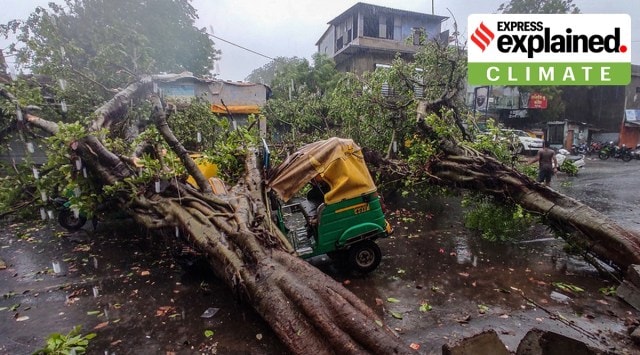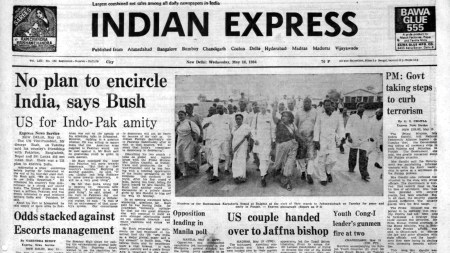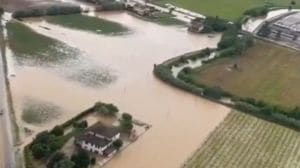- India
- International
Explained: How does Tauktae compare with other cyclones in severity and damage?
Cyclone Tauktae has killed 104 people so far, which is more than the toll from any single cyclone from the Arabian Sea over the last one decade.
 Damage caused by cyclone-induced storm in Ahmedabad (PTI Photo)
Damage caused by cyclone-induced storm in Ahmedabad (PTI Photo)Cyclone Tauktae has affected more than half of India and badly hit all states on India’s west coast. Starting off from Lakshadweep, the remnants caused rainfall up to Delhi, Bihar and Nepal on Thursday, and its clouds have even advanced into China.
Formed in the Arabian Sea, Cyclone Tauktae has killed 104 people so far, which is more than the toll from any single cyclone from the Arabian Sea over the last one decade.
Newsletter | Click to get the day’s best explainers in your inbox
Gujarat’s most severe
Tauktae was only the second ‘Extremely Severe Cyclone’ category storm to hit Gujarat in 23 years. Cyclone Tauktae made its landfall east of Diu on May 17 with wind speed ranging between 160–170 km/hr gusting to 185 km/hr. The last cyclone of equal intensity to hit Gujarat was Cyclone Kandla (wind speed 160 to 170 km/hr) that crossed near Porbandar in 1998. The following year, a ‘Very Severe Cyclone’ formed in the Arabian Sea in May, but it hit the Sindh region of Pakistan.
“The Arabian Sea does not see many cyclones, but it has a record of intense cyclones though they are not very frequent,” said Dr Mrutyunjay Mohapatra, Director General, India Meteorological Department (IMD).

Climatologically, out of the five cyclones formed annually in the Bay of Bengal and the Arabian Sea, only one develops in the Arabian Sea.
 Correction: The total deaths from Arabian Sea cyclones is 242.
Correction: The total deaths from Arabian Sea cyclones is 242.
Multiple states affected
Cyclone Tauktae brought extremely heavy rainfall and gale winds over the entire west coast during May 12–May 19. As it travelled between Lakshadweep and Gujarat, the low-pressure system intensified into an ‘Extremely Severe Cyclone’, moving parallel along the west coast.
“It is very rare that a cyclone affects so many states at a time,” said Mohapatra.
During its northward journey, Tauktae affected five states — Kerala, Karnataka, Goa, Maharashtra and Gujarat along with two Union Territories — Lakshadweep and Daman & Diu.
Cyclone Ockhi of 2017 had affected Tamil Nadu and Kerala.
On the contrary, high-intensity storms advancing diagonally from the Bay of Bengal into the east coast generally severely affect the state where it primarily makes its landfall. Or, at the most, it affects two states severely during its advancement over land. Normally, cyclones weaken upon entering land and fizzle out soon after. Thus, the damage is often limited to the coast it hits and the immediate peripheral areas.
States like Andhra Pradesh, Odisha and West Bengal along India’s east coast have frequently faced the brunt of multiple severe cyclones, such as Fani and Hudhud and the recent Super Cyclone Amphan.
Slow progress
Unlike most cyclones that are forced to weaken post landfall as they detach from the sea, Tauktae retained its intensity as a cyclone and maintained wind speeds between 60 and 70 km/hr gusting to 80 km/hr.
Cyclones are formed between the tropics while western disturbances are formed in the mid-latitudes. When the two interact, they influence each other. Such an interaction occurred at the time of landfall on the evening of May 17.
“As Cyclone Tauktae came under the influence of western disturbances, it slowed down as it was crossing over to land. This slow progress over the coast ensured that the cyclone continued to get sufficient moisture supply from the sea. Hence it did not weaken, but rather retained its intensity even 24 hours after coming over land,” Mohapatra said.
Casualties
At 104 deaths, 79 of them in Gujarat (mostly in house and wall collapses), Cyclone Tauktae has overtaken the 26 killed by Cyclone Mekanu in 2018. (Cyclone Phet had killed 44 in 2010, including 5 in India.)
While cyclones formed in the Bay of Bengal have historically killed more people than cyclones from the Arabian Sea, Tauktae has killed more people than most recent cyclones from the Bay of Bengal too. Only Cyclone Okchi, formed in the Bay of Bengal 2017, has had a higher death toll among recent cyclones so far, at 110. Tauktae’s death toll has overtaken the 90 killed by Super Cyclone Amphan (Bay of Bengal) last year.
Since 2013, IMD officials said, human casualties due to cyclones hitting India’s coasts have remained below 100 (until now). This was mainly due to the deployment of weather monitoring tools like buoys, radars, ships and satellites, improved weather models and advanced warning dissemination to the concerned states.
The IMD provides a forecast indicating a possible cyclogenesis two weeks prior to the actual event through its Extended Range Forecast. This information is then used to plan on-ground measures and timely evacuations in order to mitigate the cyclone hazards.
More Explained
EXPRESS OPINION
May 18: Latest News
- 01
- 02
- 03
- 04
- 05







































